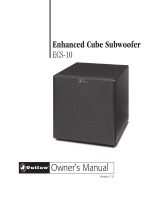www.outlawaudio.com
This warranty protects the owner of the Outlaw Audio
Wireless OAW3-t and OAWA3-r (the PRODUCT) for
two (2) years from the date of purchase.
This warranty covers all defects in material and
workmanship with the following specific exceptions.
These are:
• Damagecausedbyimproperinstallationor
adjustment
• Damagecausedbyaccident,unreasonableuseor
neglect
• Damagefromfailuretofollowinstructionscon-
tained in this Owner‟s Manual
• Damagefromtheperformanceofrepairsby
someone not authorized by Outlaw Audio
• Anyunitonwhichtheserialnumberhasbeen
effaced, modified, or removed
• Damageoccurringduringshipment
• Unitswhichhavebeenalteredormodiedin
design, appearance or construction.
This warranty covers only the actual defects within the
PRODUCT itself. IT DOES NOT cover costs of installa-
tion in (or removal from) a fixed installation, or normal
setup, claims based on any misrepresentation by the
seller, or performance variations resulting from instal-
lation related circumstances such as signal quality, AC
power or incompatibilities with speakers and/or other
system components.
During the warranty period, Outlaw Audio will, at its
option, either repair the defect, or replace the defective
product, or the defective parts, or components thereof
at no charge to the owner for parts and labor covered
by this warranty If necessary repairs are not covered by
this warranty, or if a unit is examined which is not in
need of repair, you will be charged for the repairs and/or
the examination. If non-warranted repairs are needed,
we will notify you of the estimated cost and ask for your
authorization to perform said repairs.
You must pay shipping charges incurred in getting your
Product to the factory. We will pay the return shipping
charges if the repairs are covered by the warranty. Please
save the original shipping cartons, as the unit MUST be
returned in the original carton and packing. (Replace-
ment cartons are available at a modest charge.)
If your product needs service, please call Outlaw Audio
at 866-OUTLAWS (688-5297) or 866-OUTLAWA (688-
5292).
You will need to present the original bill of sale to estab-
lish the date of purchase. In the event that the proof
of purchase cannot be established with the original
receipt, the warranty period shall be determined by
the earliest date of manufacture shown on the unit,
provided that the serial number label has not been
altered in any manner, or by our records relating to
that serial number.
In the event that you wish to return your Outlaw Prod-
uct back to us, for any reason, please call to arrange
for a Return Authorization Number. This will ensure
that your problem is discussed with a service techni-
cian who will determine if there is a quick solution to
your problem.
Outlaw Audio shall not be liable for, in any way respon-
sible for, any incidental or consequential damages of
any kind. Some states do not allow limitations on how
long an implied warranty lasts and/or do not allow
the exclusion of incidental or consequential damages;
therefore, the limitations and exclusions stated herein
may not apply to you. This warranty gives you specific
legal rights; and you may also have other rights that
vary from state to state.
THERE ARE NO WARRANTIES GIVEN BY OUTLAW
AUDIO THAT EXTEND BEYOND THE DESCRIPTION
GIVEN HEREIN. ANY IMPLIED WARRANTIES OF
FITNESS FOR PURPOSE SOLD, MERCHANTABILITY,
DESCRIPTION, QUALITY OR ANY OTHER MATTERS
ARE LIMITED TO THE TERMS OF THE EXPRESSED
LIMITED WARRANTY STATED HEREIN.
Products are sold on the basis of specifications appli-
cable at the time of sales. Outlaw Audio shall have no
obligation to modify products once they have been sold.
This warranty is applicable only in the United States.
For applicability in other countries, please call Out-
law Audio.
Outlaw Audio Limited Warranty





















